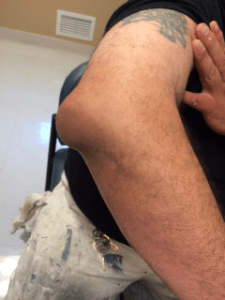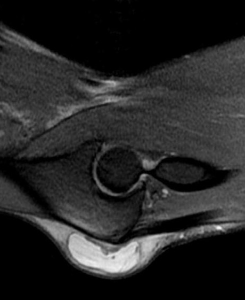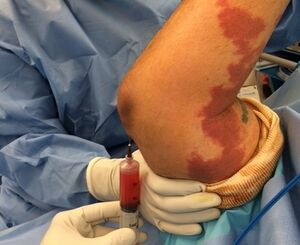Olecranon Bursitis
Olecranon bursitis (Figure 1) is a condition in which the soft tissue overlying the olecranon at the elbow is inflamed. Inflammation of the olecranon bursa can be the result of repetitive use, direct trauma or inflammatory conditions such as gout or rheumatoid arthritis. Occasionally, fluid in the olecranon bursae can become infected – a condition that requires surgical drainage. Often, however, olecranon bursitis runs an innocuous course.
Structure and Function
The body places bursae (the plural of "bursa") in those areas where the normal structures must glide (e.g., the skin overlying the olecranon) to facilitate that gliding by reducing friction.
The word “bursa” literally means “sack,” however, a healthy bursa has only a small amount of lubricating fluid within it. When bursitis is present, the inner surfaces of the bursa produce fluid, filling the bursa to become more sack-like.
Patient Presentation
The hallmark of olecranon bursitis is a mass at the elbow over the olecranon.
Tenderness, redness and warmth are classic signs, but may be absent. At times the bursa is not at all painful, unless pressure is applied.
Olecranon bursitis can be caused by conditions such as rheumatoid arthritis or gout, and therefore the presentation may be colored by co-existing symptoms of those conditions (for example, arthrosis within the elbow itself).
Patients on dialysis seem to be at particular risk for olecranon bursitis (for reasons that are not entirely clear).
At times, there is a history of direct trauma to the elbow or of repetitive use. At other times there is no antecedent history at all.
Even in cases where the bursa is not painful, pain can be produced by hyperflexing the elbow as this motion tends to increase the pressure within the bursa. Pain induced by flexion may impede full range of motion on examination.
Objective Evidence
Fluid from olecranon bursitis can be drained and sent for culture. Culture is the definitive test, although the Gram stain may be negative in many cases that ultimately turn out to be infectious.
X-rays may show an olecranon spur. There may be calcification within the bursa itself. An MRI (Figure 2) can demonstrate the fluid collection but is rarely indicated.
Epidemiology
The precise prevalence of olecranon bursitis is not known. It is a common condition, and therefore high (if not first) on the differential diagnosis list of painless masses around the elbow. Approximately 20-25% of cases of bursitis turn out to be infectious. Approximately 5-10% of patients on dialysis may have this condition.
Differential Diagnosis
There are two levels of diagnostic thinking required: First, “Is this mass bursitis?” Second, “If this is bursitis, what caused it?” (Also, the question, “Is this bursa infected or at risk for infection?” should be kept to the forefront.)
A mass overlying the elbow in the setting of normal radiographs (or radiographs showing only calcification within the bursa) can be considered bursitis until proven otherwise.
The causes of bursitis can usually be deduced from the history. As noted, increased redness, warmth and tenderness (especially in an immunocompromised patient) should prompt an infection work-up.
Red Flags
Bursal fluid can serve as a culture medium and easily become infected. Approximately 25% of cases of olecranon bursitis will turn out to be infectious. Septic bursitis is heralded by more redness and warmth and is much more likely to be painful with even gentle, short-arc motion (also known as "micro-motion") of the elbow. Patients on dialysis should be suspected of having septic bursitis.
Septic bursitis can be diagnosed definitively with an aspiration and culture. A cell count of the aspirate can be a useful clinical guide for initiating empiric treatment.
Treatment Options and Outcomes
The first line treatment of non-septic bursitis includes rest, compression (with ACETM wrap), ice, and NSAIDs. If infection is considered likely, aspiration should be performed and antibiotics started. If the infection does not clear after the first aspiration and appropriate antibiotics, surgical drainage may be needed.
Also, ensuring that any underlying process that may be responsible (e.g., gout) is well controlled is a wise step.
Minimizing the gliding across the bursa may help control the bursitis, but in general the elbow is apt to get stiff when immobilized; as such, prolonged immobilization should be avoided. Typically, immobilization with ace wrap will provide enough compression but will not completely immobilize the elbow.
If the first line treatment is not successful, needle aspiration (Figure 3), with or without a steroid injection, can be helpful. Aspiration can be diagnostic as well as therapeutic. However if the bursitis is clinically sterile and non-inflammatory and the patient has full range of motion then aspiration is generally not recommended due to the risk of iatrogenic septic bursitis.[1]
Treatment of bursitis tends to be effective, yet recurrence is common. That is often the case because the inciting cause remains present, e.g., a worker continues to put pressure on the elbow, or the gout flares up again. In general, however, long-term impairment is rare.
Risk Factors and Prevention
People whose occupations require resting on the elbows – for example, carpet installers and gardeners – are best served with elbow pads.
Dialysis, and immune compromise in general, are risk factors for infectious bursitis. Vigilance to ensure early detection of infection in these patients is advised.
Miscellany
The "bible" remedy used for ganglion cysts (smashing the mass with a heavy book) is a poor choice for olecranon bursitis. If nothing else, a heavy blow may create an open wound and increase the chance of infection.
The word "bursa" is similar to the word “bursar,” the official at a university who collects the tuition – and carries it away in money sacks. The simple English word “purse” has a similar root.
Skills
Recognize bursitis and associated “red flags.” Aspirate bursa under sterile conditions.
Resources
References
Part or all of this article or section is derived from Olecranon bursitis by Orthopaedia.com, used under CC-BY-NC-SA




